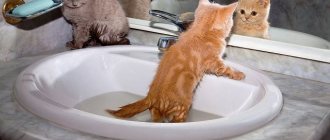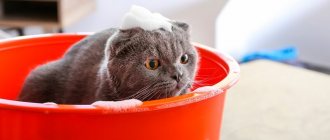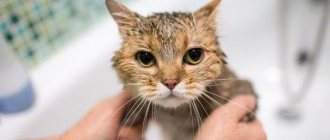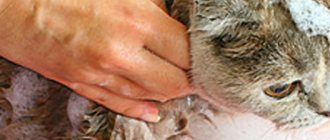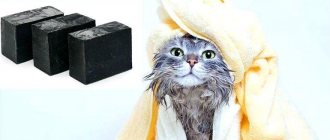Kittens really don't like water treatments. For them, water is associated with something scary and unpleasant. But no one canceled washing, because this is the key to cleanliness and health. It is better to accustom your kitten to water from an early age. So, he will get used to the procedure and love bathing. But in order for this process to take place in peace and comfort, you should take care of the bathing rules in advance. So how to wash a kitten correctly?
The advisability of bathing
Many people do not understand why bathe a kitten if nature has endowed it with a rough tongue with which it washes itself. Of course, a rough tongue helps kittens take care of their fur and remove small particles of dirt from their bodies. Kittens can spend several hours licking themselves. And this is justified. After all, wild cats carefully lick themselves before the hunt to obscure their own scent. So, hunting brings results.
Why are kittens afraid of water? It is known that cats are heat-loving animals. But when their fur coat, which protects them from the cold, gets wet, the kittens lose their ability to retain heat and freeze. Pets that are always warm and have weakened immune systems begin to get sick. Also, an inappropriate choice of shampoo will result in allergies, dry skin, hair loss and brittleness for the kitten.
Some especially love to swim and get into the water themselves, but this happens in rare families.
Then in what cases should you bathe a kitten?
- The fur was covered with a greasy coating.
- Accumulations of dirt and stickiness are visible on the skin.
- Wool has an unpleasant odor.
- Fleas.
- If the kitten is very dirty and licking becomes dangerous.
- If a purebred kitten has no fur.
What to do after swimming?
After bathing your cat, you need to dry it thoroughly with a towel, since cats get very cold after such a water procedure, especially if the apartment is not very warm. Many owners consider it lucky if the cat allows him to be warmed in a towel for at least five to ten minutes. Then the animal will most likely break free and begin to lick its coat on its own.
Pre-cover all surfaces where your pet can sit down to lick with towels. They will absorb moisture, and your sofas and carpets will remain stain-free. If your cat continues to tremble violently within five minutes, try to dry it with a hairdryer to avoid catching a cold or even pneumonia.
You already know how to bathe a cat. Now it’s worth talking about combing the fur. When the cat stops licking his fur, pick him up and brush him with a wide-toothed brush. After bathing, the coat becomes very brittle, so combing must be extremely careful.
Contraindications to bath procedures
There are also contraindications in which bathing a kitten is strictly prohibited. In such cases, it is better to wipe the coat from above with a damp cloth.
- Quarantine and vaccination. If your kitten is undergoing a two-week quarantine or has already been vaccinated, do not bathe him under any circumstances until this period is over.
- Lichen. A dangerous disease that concentrates in one place, and if you completely bathe the kitten, it can spread throughout the entire skin.
- Illness and operations. If your little pet is sick, no matter what disease, it is better to refrain from bathing until he has fully recovered.
- Stress. During times of stress, it is better not to expose the kitten to even greater stress, otherwise the small animal’s nervous system will definitely not be able to withstand it.
Have pity on your pet and do not expose it to even greater danger.
First swim
The first time is the most important. If you manage to do everything correctly, do not scare the baby, and he feels pleasure from water procedures, you will save yourself from big problems in the future.
The most common mistake is giving a kitten a bath for the first time. Large, with a lot of water, it will certainly frighten the kitten. In addition, it will be very inconvenient for you to wash it at an angle, leaning over the side and putting your hands down. Be sure that as soon as you hesitate for a second, the kitten will “fly up” onto your neck or head, climbing up your arms like up a tree trunk.
The most convenient way to wash your baby is in a basin or sink. You need to put a rubber mat or a small terry towel on the bottom. The water temperature should not be higher than 38 - 40 degrees, the “depth” should not be more than three centimeters.
It will be right if you prepare everything you need in advance: a large fluffy towel, shampoo, a bowl of water. If you have to wash the kitten alone (although it would be more convenient for two), unscrew the cap on the shampoo in advance. Prepare a couple of cotton balls soaked in sunflower oil to plug your baby's ears with, otherwise water may get into them. By the way, protect your eyes by smearing their corners with Vaseline oil.
Are you prepared? Now the most important thing is how to bathe a kitten. Take him by the withers with your hand (as the mother cat took him with her teeth) and place him in a basin of water. It doesn’t matter whether he sits or stands on all four legs, the main thing is that his posture is sufficiently stable.
Wash your baby carefully, protecting the head (especially the eyes and ears) from getting water. Do not turn on the shower - strong water pressure can frighten the kitten. Always talk to him in a normal, calm voice.
The bathing procedure should not be too long: shampoo “eats” the grease from the hair, and without it, your pet’s “fur coat” will not be shiny and smooth. There is also a risk of drying out the skin, which will become easy prey for harmful microorganisms and various infections.
After the washing is over, wrap your pet in a towel so that it is comfortable for him to breathe and look around, but under no circumstances wrap him up “with his head.” Hold the baby in your arms for a few minutes to dry him, and then put him down on the sofa - he will clean himself up. You will make sure that there are no drafts and your pet will not catch a cold.
And the last point: praise the baby for being brave and obedient (you can even play a little trick) and reward him with something tasty that he really likes. For pedagogical purposes.
At what age can you bathe a kitten?
Veterinarians do not recommend bathing a kitten until 3 months old, since during this period their skin glands are just forming. If the protective secretions are washed off from the skin, the kitten may develop dermatitis. In the first month, the kitten is calmly licked by its mother. Subsequently, he learns to do it himself and this will be enough for him.
Already after three months of age, if the kitten knows its owners and trusts them, you can bathe the animal for the first time. You don’t have to put this procedure aside. It is better for a kitten to get used to water at an early age.
If a kitty or cat has gotten very dirty, but they have not yet learned to lick themselves, you can wipe the dirty areas with a damp cloth.
Begin washing with awareness and confidence so that your cat feels your love for him.
Optimal age for first bathing
Cats are excellent swimmers. Some varieties, such as the Turkish Van, love water and are willing to swim every day, this is due to the special structure of their coat. And the dislike of washing in most breeds is due to poor thermoregulation of these animals.
A wet cat, in addition to experiencing unpleasant sensations from the cold, is an easy prey for a hypothetical enemy, since it is helpless and its smell at this moment is too distinct. Therefore, the animal is in a hurry to shake the water off its fur and immediately dry itself with its rough tongue.
If the pet was purchased from a nursery, then there is no need to rush into the first bath. It is necessary to give the kitten time to get comfortable in the new home, because moving is a huge stress for the baby and it is not advisable to aggravate it.
But a kitten picked up on the street must not only be washed, but also treated for external parasites and dewormed if its health condition allows this.
Very small kittens, up to three months old, can simply be wiped with a wet sponge and combed.
Pedigree kittens, especially semi- or long-haired breeds, begin to be accustomed to water procedures from this age. This is especially true for Persian, Angora, and British cats.
If the animal is going to be exhibited, then it will have to be washed before each show, so it is important that this procedure becomes familiar and loved for the pet.
Bathing frequency
But you shouldn’t immediately run out and wash your pet almost every day. Such a frequent procedure will not benefit the kitten. With frequent bathing, the coat deteriorates and the skin becomes dry.
Domestic kittens should be washed 2-4 times a year. For example, you can wash your pet once every quarter (3 months).
If your kitten goes for walks outside, or you go out with him periodically, then after each walk you should definitely wash his paws. Well, general bath procedures should be carried out 6-10 times a year.
For hairless kittens, bath procedures are considered almost the basis of everything. Since their skin is not protected by fur, it secretes a secretion that quickly begins to spread an unpleasant odor, and such kittens get dirty faster. Therefore, such kittens are washed approximately once a month.
Also, veterinarians recommend bathing a kitten once in winter and autumn, and twice in spring and summer.
Do not neglect the health of your pet; take washing with great responsibility. The main thing is not to go through this procedure frequently.
The ABCs of Bathing
Considering the risks that water treatments can cause to animals, they should be approached responsibly. Any deviation from the rules can lead to dermatological or colds.
First bath
In order not to traumatize the baby’s psyche, the first water procedure should be as comfortable as possible. The quality of its implementation determines the attitude towards subsequent bathing.
You need to get used to water from an early age. At 3 months, the kitten can already have a bath day. Before this, responsibility for the cleanliness of the pet lies on the mother's shoulders. If he is very dirty, he can be given a bath even at 1 month of age.
The first bath is carried out when the kitten reaches 3 months.
Frequency of bathing
Considering the love of the feline family for cleanliness, washing should be an auxiliary activity, but not the main one. Frequent bathing has a negative impact on the condition of the coat.
It is advisable to arrange scheduled washing no more than once every 6 months. Some cat owners reduce this time period to 4 times a year.
The frequency of water treatments depends on the breed of the pet, the condition of the hair, the presence of parasites and lifestyle. Hairless cats, for example, should be washed more often than long-haired cats. Those who like to spend time outdoors are bathed up to 6 times a year, unlike those at home. Before participating in exhibitions, unscheduled swimming is possible. In addition, animals need to clean their paws every time after being outside.
The frequency of bathing for free-range cats is once every 2 months.
General recommendations
Before you begin water procedures, you need to familiarize yourself with the advice of experienced cat owners and veterinarians. To make this event comfortable and not cause harm, it is advisable to adhere to the following rules:
- Wash on an empty stomach or after a small snack.
- Avoid contact with water for 14 days after vaccination or if you have ringworm.
- It is advisable to adjust bathing to seasonal molting. During this period, pets lick themselves more often, which is fraught with accumulation of hair in the stomach and disruption of digestive processes.
- Pedigree animals are given unscheduled baths before participating in exhibitions.
- If the cat is very dirty and is unable to cope on its own, an additional bath day is arranged.
Some owners use the services of groomers for their first bath. Such a service costs about 400-600 rubles and allows you to learn all the intricacies of the procedure.
Long-haired cats should be bathed during shedding.
Strategically important places
Some parts of kittens' bodies get dirty more than others. During the bathing process, special attention should be paid to the following areas:
- armpits;
- behind the ears;
- stomach;
- paws;
- anal area.
Animals' ears also get very dirty, but they can be cleaned with cotton swabs.
Cats have highly sensitive paws equipped with sensory organs. Nerve receptors help them hunt and maintain balance. They react very sensitively to any changes in the environment, including temperature. Too cold or hot water can cause severe pain in your pet.
Paw pads are considered one of the most sensitive places on a cat's body.
Detergents
The kitten hair care line is presented in several versions - shampoos and conditioners for normal, dry, oily and damaged skin. Since kittens have more delicate skin and fluffier fur than adults, they need gentle products.
Based on consistency, washing cosmetics are divided into 3 groups:
- Liquid. This category includes soap-based shampoos and conditioners. Most in demand.
- Powdery. Indispensable for pets afraid of water. Applying cleansing powder is more labor-intensive, but relieves the kitten from a stressful situation. Not suitable for animals with dark fur.
- In the form of sprays. A convenient sprayer allows for precise application of the product. Helps with partial bathing and for working with tangles.
Dry shampoo can be made at home. To do this, mix equal parts baby powder and cornstarch.
8in1 Waterless Cat Shampoo Spray - popular waterless shampoo
Table 1. The best shampoos for bathing kittens
| Direction | Shampoo name |
| Antiparasitic | “Disinfectant”, “Lugovoi”, “Tar Celandine”. |
| Medicinal | "Doctor", "BioVax". |
| During molting | Yuup Restructuring and Strengthening, Tropiclean. |
| Dry | Trixie Trocken Shampoo, Mr. Gee. |
| From tangles | FURminator anti-tangle spray, Perfect Coat Shed Control and Hairball. |
| Carers | Iv San Bernard Antistatic, “Gentle”, Artero 4Cats, “Marine”, “Velvet”, Artero Basic. |
| To add volume | Anju Beaute Texture Volume. |
The use of volumizing products is not recommended for Siamese kittens.
Rules of application:
- When choosing detergents, you should take into account the type and color of the coat, as well as the condition of the skin.
- Shampoos for long-haired kittens are not suitable for pets with short hair and undercoat.
- Detergents have different PH levels, which directly affects the silkiness and grooming of the coat. If for humans they are designed for an acid-base balance of 3.5 to 4.5 units, then for cats you need to look for products with a pH of 6.5.
- It is preferable to buy concentrated shampoos. They are more expensive than regular ones, but they are more economical in consumption.
- Herbal shampoos are not used for silver, white and blue kittens.
- Siamese and Abyssinian babies are not recommended to use care products to create volume.
- You need to purchase specialized products designed for cats or for cats and dogs. The use of exclusively dog shampoos is possible only before participating in exhibitions.
- Most detergents need to be left on the wool for up to 7 minutes. This is especially true for medicinal products.
- It is not advisable to use 2-in-1 shampoo-conditioners.
- Human cosmetics are not suitable for kittens because they kill the skin's defenses.
The best conditioners for bathing babies are those produced by Tropiclean and Iv San Bernard.
Iv San Bernard is a popular Italian brand among groomers
How to prepare for washing
Before starting bath procedures, it is important to prepare in advance for such a serious event. The main thing when washing a kitten is not to scare it, so that it does not experience unpleasant sensations when it comes into contact with water.
General recommendations to follow include:
- Close the door tightly and avoid drafts.
- Trim your pet's nails and brush them beforehand.
- To begin, add water 10 cm from the bottom. Then add, but not above the shoulders.
- The water temperature should be between 35-40 degrees.
- Do not bathe your kitten immediately after eating. About 4 hours must pass before you can take bath procedures.
The main thing is that the fluffy does not participate in the preparatory process.
Most of all, kittens are afraid of the sound of water from a tap or shower. Therefore, it is not recommended to turn them on while your pet is near you.
Selection of hygiene products
There is a huge selection of pet wash products on the market. Such shampoos are distinguished both by skin type and consistency. But kittens need gentle products and they need products that are specifically designed for them. It is worth consciously approaching the choice of shampoo with which you will wash your kitten.
- Liquid shampoos will make your kitten's fur soft and fluffy. This product foams quickly, so only a small amount of shampoo is needed.
- Dry shampoos are not used with water, so the kitten must be dry. Shampoo is applied to the skin and combed off along with the dirt.
- Sprays are also used on dry skin.
- Special shampoos are aimed at combating problems and have the desired effect. Such shampoos fight parasites, and there are also medicinal ones for damaged kitten skin.
Never use the shampoos that we humans use to wash our hair. For animals, such products are very aggressive.
Inventory
Prepare in advance everything you will need when washing your kitten.
- Veterinarians do not recommend bathing kittens in the bathtub as it is too big for them. It is better to prepare a special bath for bathing children and a ladle.
- Towels and rags. You will need towels to dry the kitten after the bath, and place a rag on the bottom of the bath to make it more comfortable for the kitten to stand.
- Place shampoo, small washcloths, and toys next to the basin.
- To protect your head and ears, you can purchase special hats and earplugs.
- For calm incubation of all procedures, you can buy a special net for bathing for the kitten. This way he won’t run away and won’t scratch you.
With such a combat set, you will definitely be 100% ready to bathe your pet. Just don’t forget to call someone for help to be on the safe side. Washing your pet is much easier with two people.
There are special caps for washing kittens, nets and fastenings.
Preparing for a swim
Before you teach your cat to bathe, you should prepare it for what is happening:
- Start classes from childhood, bring the cat into the bath, put it in the sink, let him be alone for a few minutes and get used to it;
- After getting used to it, you can fill the bathtub or sink a little with water and put your pet’s favorite toys in there;
- Before bathing, the cat's fur should be thoroughly combed to remove dirt and tangles;
- Before bathing in the bath, it is better to cut the nails so that the pet does not scratch or get stuck in the towel;
- It is recommended to pre-drip your eyes with soap to avoid irritation and cover your ears with cotton balls;
- To make it more comfortable for the cat to bathe, you should put a towel on the bottom of the bath, then it will not slip;
- During the procedure, it is better to invite an assistant to help hold the pet.
To accustom you to water and make the procedure as comfortable as possible, you need to prepare the accompanying accessories and tools:
- A pair of gloves;
- Special shampoo for cats, but not ordinary human shampoo, because it is extremely dangerous for their health;
- Large watering can;
- Large towel;
- Cotton pads;
- Napkin;
- Eye drops.
When bathing your cat, it is worth setting the pressure to medium so that the noise from the shower does not irritate or frighten him. After completing the procedure, the pet can be dried with a hairdryer at minimum temperatures. But it’s better to dry it well with a towel, because it’s less traumatic.
Bathing a kitten - how the procedure works
The most common bathing is done with liquid shampoo, so use that. How to bathe a kitten correctly and without harm:
- Place the kitten in a bath that is already filled with water at about 40 degrees. The kitten must reach the bottom and not drown. Grab the kitten by the scruff of the neck. So, he will not have the opportunity to flounder and scratch. Calm the baby, talk to him, praise him.
- First, wet his fur with a ladle. Do not wet your ears and head - it is better to avoid getting water in these places. You can take a shower instead of a ladle, but only if the kitten is not afraid of the stream that runs from there.
- Pour a small amount of shampoo onto your hand and rub between your palms. It is important that the foam has already formed on your palms, this makes it easier to apply it to the wool. Apply shampoo to the back, paws, tummy, and tail. Don't touch your head or ears.
- Take a washcloth designed specifically for your pet and gently soap your cat. Distribute the foam in all places. Pay special attention to the pads on the paws, genitals, armpits, chin, neck. A lot of dirt accumulates in these places, because they are difficult for the kitten to reach. Wash off dirt thoroughly.
- The most unpleasant thing is washing your hair, so we postponed this item to the very last. Using a washcloth, gently wet your head and ears.
Carefully! Water should not get into the eyes and ears, as the pet may experience inflammatory processes.
- Lather your hair, also carefully, massage lightly. You only need a little foam on your head.
- Now you can wash it off. Using a shower or a ladle, water the kitten from top to bottom, that is, from head to tail. There should be no foam left, all fur should be clean, otherwise the kitten may be poisoned by hygiene products when licking itself.
- Place the kitten in a warm, terry towel. Let him warm up a little in this towel. Take a second towel and blot all areas so that no water remains.
How to bathe an adult cat?
If you have not taught your pet to bathe from a young age, then this procedure becomes much more complicated. However, do not think that your attempt is doomed to failure. Below we will present you with tips and recommendations from experienced owners and veterinarians who will certainly answer the question of how to bathe a cat without scratching it.
To bathe an adult animal, use dry or liquid shampoos for cats; in rare cases, it is allowed to use shampoo for people, as well as baby soap.
How to bathe correctly for the first time
It is important that after its first wash the kitten has only pleasant memories. Therefore, carry out your bath procedure in comfort and coziness. For kittens who are trying to wash their coat for the first time, you should follow all the rules described above. And also adhere to the following tips.
Cheer up your four-legged friend.
- Introduce the kitten to the bathtub or basin. Show him the tap, the water. Also bring his toys, perhaps he will be calmer with them.
- For the first time, use unscented shampoos.
- It is better to wash a kitten for the first time not alone, but with someone. So, another person will hold and pinch the ears while you wash the kitten.
- Gently soap the kitten with a sponge and rinse off the foam thoroughly.
- Wrap the kitten in a warm towel and sit with it for about 10 minutes. Later, take another dry towel and wrap it again. Place the kitten in a warm place: a bed or a house.
- After washing, treat your purr with something tasty to make him feel better.
How often, how many times
Some veterinarians advise washing a kitten no more than once every 2 or even 3 months, while others advise almost every 4 weeks. At the same time, try to keep the water at the same temperature as the animal’s body, usually 38 degrees.
Kitten after bathing
As we have already said, it is up to you to decide on what day to wash the kitten, but it is better to do this after 2 weeks have passed from its settlement with you. It is worth repeating bathing activities every 2-2.5 months, or more often if the baby gets dirty, for example, by turning over a flower pot.
So, we advise you to adhere to the following bathing scheme:
- December-February – 1 swim, for example, in January;
- March-May – 2 baths: one in early spring, the second in mid-May;
- June-August – 2 baths: at the end of June and at the end of August;
- September-November – 1 swim in mid-autumn.
That is, it costs to wash a kitten once at 1 month, and twice at 4 months. At the same time, keep the bathroom door tightly closed so that the baby does not jump into the room. After all, washing a kitten at 3 months is relatively easy, but he can also be too frisky. And then make sure that his fur is not tangled; we even advise you to comb it first.
It is worth pouring water over the baby from a stationary shower or hose. If he doesn't like them, we recommend using a sponge and a bowl. This way you can easily wash a two-month-old kitten or even an older pet.
If the kitten is against
It also happens that a kitten is categorically against any water. Perhaps the kitten has bad memories creeping in, or water for him is an association of something terrible. But in order to solve such a problem, you should show patience and love for your baby.
Before washing, play with the kitten. During the game he will relax a little and get tired. This way he won’t have the strength to fight water wars in the bathtub.
The main thing is not to feed the kitten before the bath procedure.
While you put the kitten in the water, distract him with toys. There is no need to throw the kitten into the water, do everything smoothly and continuously.
If you still fail to wash your kitten, the only solution is dry shampoo or spray. Or wipe the wool with a damp cloth or napkin. So, you will not expose the kitten to water, but simply clean it with dry shampoo.
Do not shout or scold under any circumstances. Talk calmly and kindly to the kitten, praise it, laugh quietly and play.
Preparation rules
The bathing process can be divided into 3 stages:
- preparation;
- bathing;
- drying
Before the washing procedure, it is necessary to prepare the bathroom and the animal itself.
When caring for your cat, you will definitely need a furminator.
Baths
You should remove all hanging towels in the bathroom, because if the cat breaks out, he will cling to them, tear them, pull out the ties, and throw them to the floor.
You also need to put away soap dishes, shampoos, washcloths - everything that can get under the pussy's paw. It is better to bathe the animal in a bathtub with a terry towel or rubber mat placed at the bottom so that its paws do not slip along the bottom.
For a small kitten, the size of the bath will be large and will cause fear, so it must be placed in a bowl or in a sink. Since a cat’s body temperature is 38–39 °C, a comfortable water temperature for her will be 38–40 °C. The air temperature in the bathroom should not be lower than 15 °C.
Water must be collected in advance so that its noise does not frighten the mustachioed one. Its volume should be so large that it reaches the animal’s abdomen—approximately 15–20 cm.
Important! Shampoo for bathing a cat must be purchased specially, taking into account the characteristics of its fur. You should not wash it with soap, as it dries out the skin.
You should also prepare in advance all the necessary bathing accessories: shampoo, brush, washcloth, towels, laying them out in a row. The shampoo should be in the open state, because then you simply won’t be able to open it - your hands will be busy holding the shampoo. All accessories should be nearby so that you don’t have to reach far for them.
For washing, you should invite an assistant, since this procedure is best done with 4 hands.
Kota
Before you wash your cat in the bathroom, his claws need to be trimmed.
Find out how to make your own cat scratching post.
If there are hairballs on his fur, they must be carefully removed by hand. Before bathing, it is advisable to play with the kitty so that it relaxes. It is also important to prepare kind words for her and be patient.
The animal should be bathed after visiting the tray.
After all the preparatory procedures, you can already start swimming.
Breed characteristics and bathing
There are additional bathing instructions for different breeds. There is also an individual approach to washing, because everyone’s character and genes are different.
- The Scots and British wash themselves very carefully. And they take care of their fur many times better than others. Therefore, such kittens can be washed twice a year.
- Long-haired Siberian and Persian kittens, as well as fold-eared ones, are washed six times a year. Before washing, you should comb the coat thoroughly.
- Since the fur of white kittens is subject to more contamination, they can be washed with shampoos that are aimed at whitening.
- Sphynxes and other hairless kittens are washed only with special shampoos designed for their breed. I don’t wash my hair, but wipe it with napkins. After washing, be sure to rub with baby cream, but so that the kitten does not lick it off.
- Burmese kittens should be wiped daily with a damp cloth and bathed only if they are very dirty. This is because this type of breed has very thin and short hair.
Before bathing your pet, you should learn more about the characteristics of your cat.
Features of bathing small sphinxes
It’s clear how to bathe an ordinary kitten. However, when it comes to other breeds, a person may become confused. You need to wash hairless Sphynx kittens according to the method presented above. But after the procedure, you need to cover his body with baby cream.
You need to start accustoming cats to water procedures from childhood. While the kitten is small, you can try and instill in him a positive attitude towards water. The most important thing is not to scare him during the first bath and not to cause him pain.
Source
Drying your pet
The moment has come when it's time to dry. The main thing is to immediately wrap the kitten in a towel after washing so that there is no risk of getting sick. There are two types of drying:
- Leave the kitten in a warm room for 12 hours so that all the fur dries on its own. The kitten will take care of drying itself and will begin to lick itself for a long time. After all, he has special scales on his tongue that remove excess moisture.
- Blow drying is possible if the kitten is not afraid of this scary sound. Blow-drying is also better for long-haired kittens, as their fur takes longer to dry than usual and they need a little help. The main thing is to comb the coat while drying. It is recommended to dry with warm air so as not to burn or freeze your pet.
The main thing is to avoid open windows and drafts. Do not let the kitten outside while drying. Kittens are very prone to infections if their coats are wet.
Drying the animal
The freshly washed cat, wrapped in a bath towel, is carried into the room. For long-haired breeds, you may need another towel if the first one gets wet and stops collecting moisture. If the animal is not afraid of the sound of a working hair dryer, then 10 minutes after washing you can start drying. The device regulator is set to warm air - too hot can burn delicate skin.
The next step is to carefully comb the fur and untangle any tangled areas. After water activities, the cat should stay in a warm room for at least 1 hour - otherwise it will catch a cold.
Should cats be washed? This is an interesting question to which not everyone knows the answer. Hygiene measures are often unpleasant for both the pet and its owner. But sometimes it is impossible to do without them. Compliance with washing rules will reduce discomfort in the animal and prevent stress. After each bath, your furry pet should be treated to a special treat for cats - it will calm him down and increase the level of trust in his owner.
Expert advice
Bathing is a simple process that requires patience. And if you approach this with all your heart, the procedure will be fun. Bathe the kitten correctly, without causing him any unpleasant sensations, then he will get used to it and will not be afraid of water.
In conclusion, experts recommend using a couple more tips.
- It is best to bathe a kitten during shedding. So, the excess hair will go away, and the kitten will not be able to swallow some of the hairs that contain harmful substances when licking.
- If the kitten has already gotten very dirty somewhere, for example, in oil, then before bathing you should lubricate this area with butter and blot it with a paper napkin.
- If your kitten has fleas, it is important to use a specialized shampoo. Therefore, first, start washing the kitten from the neck so that while washing the body, fleas do not run to the head.
Choose exceptionally soft and comfortable towels for your pet.
How to wash representatives of different breeds
Representatives of different breeds require a special approach to bathing:
- Shorthaired Scots and Britons who devote a lot of time to grooming can be bathed once every six months.
- Long-haired cats, such as Persian or Siberian cats, need to be washed every 2 months.
- White kittens are bathed with whitening shampoos.
- Detergents for long-haired breeds are not used for short-haired kittens with abundant undercoat.
- It is not advisable to bathe kittens of white and blue colors, particolors and silver pets with herbal shampoos.
- To wash Sphynxes and other hairless cats, specialized shampoos are used that care for the skin. The head is wiped with sanitary napkins.
- Products for adding volume are not suitable for animals with tight-fitting hair without undercoat (Siamese, Oriental, Abyssinian cats, etc.).
Drying wool correctly
The animal should not be cold after bathing, so it is wrapped in a towel that absorbs excess moisture.
Then the towel is replaced with a dry one and the pet is taken to the room. It is important to create a comfortable air temperature in the room (about 24⁰ C), and close the windows tightly. A cat can easily catch a cold from a draft. Persians, Scots, Siamese, sphinxes and rexes are especially sensitive to cold.
The hairless cat needs to be thoroughly dried, gently blotting the body, but without rubbing. And then wrap it in a dry, warm towel and hold it in your hands until it is completely dry and warm. Some breeders advise lubricating the skin with baby cream or natural oil (shea, olive, palm). This will protect it from peeling and cracking. Woolen animals must be dried with a hairdryer , since a fur coat can dry up to 12 hours at room temperature. And in representatives of long-haired breeds, wet hairs will simply stick together and turn into tangles.
Do not bring the device closer to a distance of less than 30 cm from the cat. For drying, slow or medium speed and gentle mode are suitable. It’s great if you have a low-noise hairdryer in your home. First of all, the air stream is directed to the head, then the chest, front legs, stomach and back. To prevent the cat from getting nervous, the hind limbs and tail are dried at the end. These places are especially sensitive, so they are always zealously protected from the encroachments of strangers. After the fur coat is completely dry, comb it with a brush. The remnants of dead hair are removed, and the pet becomes plush.
Be sure to treat the cat with his favorite treat after all the “bullying” is completed. Then he will forget about the unpleasant sensations, and the washing procedure will leave only positive emotions.
The importance of choosing the right detergent for your furry pet
If the shampoo is chosen incorrectly, it will negatively affect the condition of the cat's coat.
The hair will become brittle, dull, begin to get tangled, and form clumps. The skin condition may worsen. When using inappropriate products, the dermis becomes dry and there is a risk of dandruff.
It is important to take a responsible approach to choosing shampoo.
Your pet needs to be given proper care to avoid problems with its fur and skin . Responsibility for the health of the animal lies with the person.
What happens if the animal is regularly washed with a non-special product?
The systematic use of shampoos that are unsuitable for cats leads to changes in the structure of the hairs, the activity of the fatty glands is disrupted, and the condition of the skin deteriorates .
The development of allergies cannot be ruled out. Because of this, the immune system weakens. The pet becomes more susceptible to various diseases.
How to wash a cat
The condition of the animal's skin is greatly influenced by what you bathe the cat with. This should be a special pet shampoo that best suits the type and length of the coat.
Breeders recommend professional products. Their advantages:
- no flavorings;
- natural composition;
- improve the quality of wool and allow you to wash away dirt well.
If there is no special shampoo and the cat needs to be washed, in exceptional cases and once it is permissible to use shampoo for children under 3 years of age.
Is it possible to wash a cat with regular shampoo?
Cats have drier skin than humans. Therefore, you cannot bathe a kitten or an adult animal with either baby soap or human shampoo. Using regular shampoo will dry it out, which may result in hair loss.
You should also not wash your cat with laundry soap. The product changes the state of the microflora of the skin and dries it out. From such experiments, the coat becomes dry, dull, and allergies may develop.
Shampoos for other animals are not suitable either. Detergents, for example, for dogs can cause serious allergies in cats even after the first use.
Basic rules for washing kittens
If you follow a few simple rules, your kitten will experience significantly less stress during your next bath.
Recommendations:
- The procedure should not be carried out immediately after eating.
- It is advisable to wash the kitten during shedding.
- Before bathing, the coat must be combed and rugs removed.
- There should be no drafts in the treatment area.
- For the first time, it is best to take unscented flea shampoo.
- The temperature in the pool should not exceed + 40 and should not fall below +37.
- The head should be wetted with a sponge, not with water from your hand.
When bathing for the first time, even an assistant does not interfere: one person calms the baby, and the other performs all the necessary actions.
Which shampoo to choose?
The question of what to lather the fur with: regular shampoo or choose a special product for washing your cat at home is controversial. Artificially bred breeds have thin and delicate skin, often susceptible to allergies. Aggressive shampoo intended for humans, and even more so soap, can cause great harm. For example, cause eczema, dandruff, dryness and cracked skin.
To bathe a British or Scottish cat, you will have to pick up a special cleaning product from a veterinarian that will eliminate the unpleasant odor and add shine to the coat.
For babies, it is better to buy products for kittens that protect delicate skin from damage and do not irritate the mucous membranes. Old cats should be washed with hypoallergenic products that eliminate itching and flaking.
© shutterstock
Washing with baby shampoo is undesirable even for domestic felines. But in rare cases, this rule can be neglected if nothing else is at hand.
How to teach a kitten to bathe
Bathing is a serious stress for your pet. To avoid health problems and not to injure the baby’s psyche, he needs to be prepared before the first wash.
Important. Kittens subtly sense people's moods. If the owner is nervous, the anxiety will be transmitted to the pet. Therefore, before swimming you need to calm down and relax.
First, the kitten is placed in a dry bath and they try to play with it. He needs to understand that it is safe here. When the baby gets comfortable, open the tap. Some pets themselves show interest and begin to play around with a thin stream of water.
The process is repeated several times until the kitten becomes absolutely calm about the procedure. Cats that cannot get used to water can be bathed in mesh bags. They restrict the movement of animals, but do not prevent water and detergents from entering the body.
